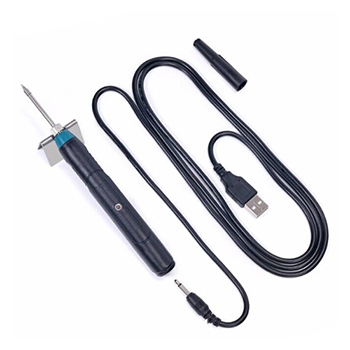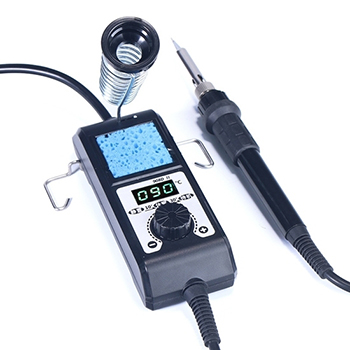How to Use Soldering Iron?
A soldering iron is the most commonly used welding tool for electronic engineers. Using a soldering iron well will save us a lot of time in our work. For friends who are not familiar with electric soldering irons, it is still very difficult to use. Today, ATO will explain to you the use of electric soldering iron and welding skills, so that more people are familiar with electric soldering iron, let's learn it together.
Pre-weld treatment
Before soldering, pre-soldering treatment should be performed on the component pins or the soldering parts of the circuit board.
- Remove the oxide layer on the welding part: A knife can be made from a broken saw blade to scrape off the oxide layer on the surface of the metal lead to expose the metal luster of the lead. The printed circuit board can be polished with fine gauze paper, and then coated with a layer of rosin alcohol solution.

- Component tin plating: Tin on scraped leads. After the lead wire is dipped in rosin alcohol solution, press the tip of the hot soldering iron with tin on the lead wire and turn the lead wire. The leads can be evenly plated with a very thin layer of tin. Before the wire is welded, the insulation sheath should be peeled off, and then the above two treatments can be performed before formal welding. In the case of multi-strand wires, they should be twisted together after polishing and then tinned.
Components must be clean and tinned. During the storage of electronic components, due to the effect of air oxidation, a layer of oxide film is attached to the component pins, and there is other dirt. Before soldering, the oxide film can be scraped off with a knife, and a layer of solder (commonly known as enamel) should be applied immediately, then proceed to soldering. After the above treatment, the components are easy to weld firmly, and the phenomenon of virtual welding is not easy to occur.
After the pre-welding treatment is done, the welding can be officially carried out.
Welding method
Weld Check Short
- Before using the soldering iron, check whether the soldering iron is well grounded, and pay attention to whether the power of the soldering iron matches the soldering point. Hold the electric soldering iron in your right hand, and use needle-nose pliers or tweezers to hold components or wires in your left hand. Before soldering, the electric soldering iron should be fully preheated. Wash the tip of the soldering iron with a sponge and plate it with tin. The surface of the tip of the soldering iron should be tinned, that is to say, a certain amount of solder should be applied.
- Put the tip of the soldering iron close to the solder joint, and the electric soldering iron is at an angle of about 60°C to the horizontal plane so that the molten tin can flow from the soldering iron tip to the solder joint. Clean and tin-plate the components to be soldered, and then solder them. The temperature should not be too high and the time should not be too long during soldering. The time the soldering iron tip stays at the solder joint is controlled within 2 to 3 seconds. Pay attention to the penetration of solder joints and the distance between points, and the coordination of rosin and solder paste.
- Lift the tip of the portable soldering iron, and still hold the component with the left hand. After the tin at the solder joint is cooled and solidified, the left hand can be released. After welding, it is necessary to check whether the welded parts have false welding, no welding, wrong welding, and short circuit.
- Rotate the lead wire with tweezers to confirm that it is not loose, and then cut off the excess lead wire with partial jaw pliers.
What should we pay attention to?
Soldering temperature and soldering time
When soldering, the temperature of the portable soldering iron should be higher than the temperature of the solder, but it should not be too high. It is better that the soldering iron tip contacts the rosin just before smoking. If the soldering time is too short, the temperature of the solder joints is too low, the solder joints are not fully melted, and the solder joints are rough, then it is easy to cause false soldering. On the contrary, the soldering time is too long, the solder is easy to flow, and it is easy to overheat and damage the components.
The amount of tin on the solder joint
The amount of solder on the soldering point should not be too small, if it is too small, the welding will not be strong, and the mechanical strength will be too poor. And too much is easy to cause a lot of appearance but not connected inside. The solder should just submerge all the component leads on the soldering point, and the outline should be faintly visible.
Pay attention to the position of the soldering iron and the soldering point
When beginners solder, they usually move the soldering iron back and forth or squeeze hard at the soldering place. This method is wrong. The correct way is to use a soldering iron to touch the soldering point so that the heat transfer area is large and the welding speed is fast.
Welding quality
When welding, it is necessary to ensure that each solder joint is firmly welded and in good contact. A good solder joint should be bright, smooth, and free of burrs, and the amount of tin should be moderate. The tin and the object to be welded are firmly fused, and there should be no false welding or false welding.
False welding means that only a small amount of tin is welded at the solder joints, resulting in poor contact, which is sometimes on and off.
False welding means that it seems to be welded on the surface, but it is not actually welded. Sometimes the lead wire can be pulled out from the solder joint by pulling it out by hand.
These two situations will bring great difficulties to the debugging and maintenance of electronic production. Both of these conditions can only be avoided with extensive, careful welding practice.
Be sure to control the time when soldering the circuit board. If the soldering time is too long, the circuit board will be burnt, or the copper foil will fall off.
When removing components from the circuit board, stick the tip of the electric soldering iron on the solder joint, and pull out the component after the tin on the solder joint melts. Flux (rosin and solder oil) is the key when soldering. Fresh rosin and non-corrosive solder oil can help you complete the soldering well and can make the surface clean and beautiful. You can use more flux when using it.
Soldering skills are also key. During the maintenance fabrication process, welding work is essential. It not only requires the components to be fixed on the circuit board but also requires that the solder joints must be firm and smooth, so the quality of the soldering technology directly affects the success of electronic production.
The choice of soldering iron
The power of the soldering iron should be determined by the size of the soldering point. The area of the solder joint is large, and the heat dissipation speed of the solder joint is also fast, so the power of the electric soldering iron should also be larger. Generally, the power of the electric soldering iron is 20W, 25W, 30W, 35W, and 50W, etc. It is more appropriate to choose a power of about 30W.
After the electric soldering iron has been used for a long time, a layer of oxide will be formed on the tip of the soldering iron. At this time, it is not easy to eat tin. At this time, you can use a file to file off the oxide layer. After the soldering iron is powered on, insert the rosin when the tip of the soldering iron is slightly hot, coated with solder to continue to use. The newly bought electric soldering iron must also be tinned before use.
Solder and Flux
Choose solder wire with a low melting point and a non-corrosive flux such as rosin. It is not suitable to use industrial solder and corrosive acid solder oil. It is better to use solder wire containing rosin, which is very convenient to use.
Inspection after welding
After soldering, it is necessary to check whether there are missing soldering, virtual soldering, and component short circuits caused by solder flow. False soldering is difficult to find, you can use tweezers to clamp the component pins and pull it gently. If you find shaking, you should repair the soldering immediately.

